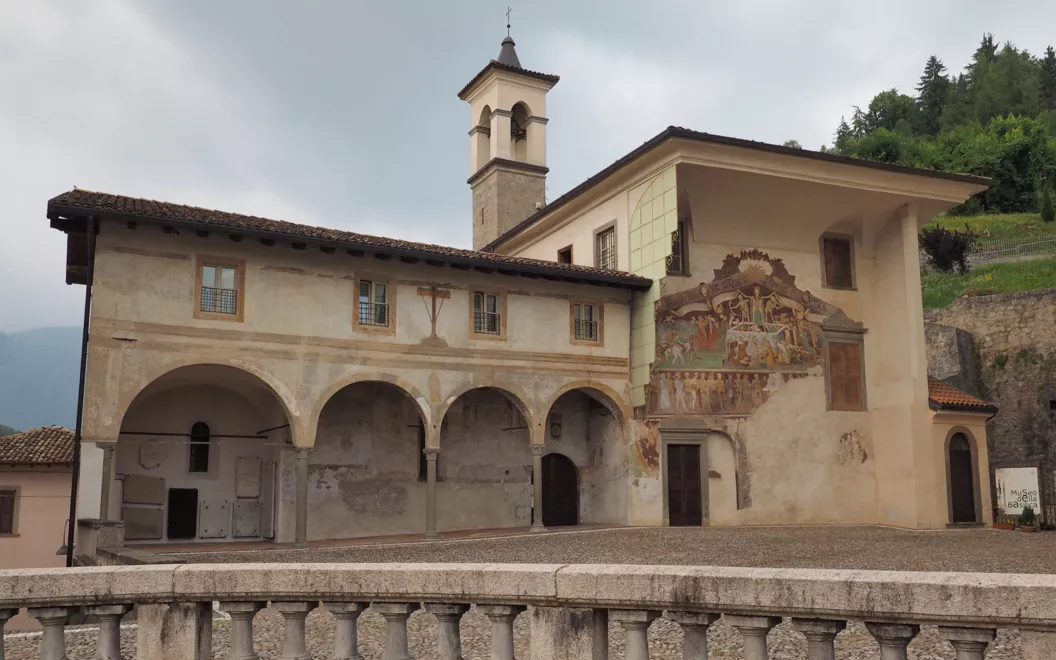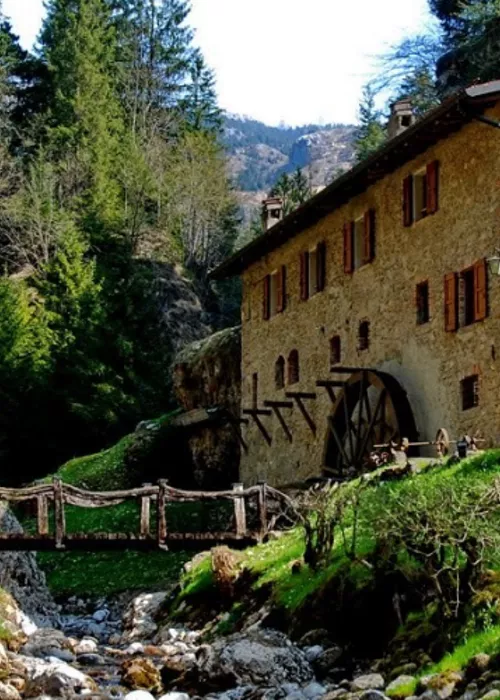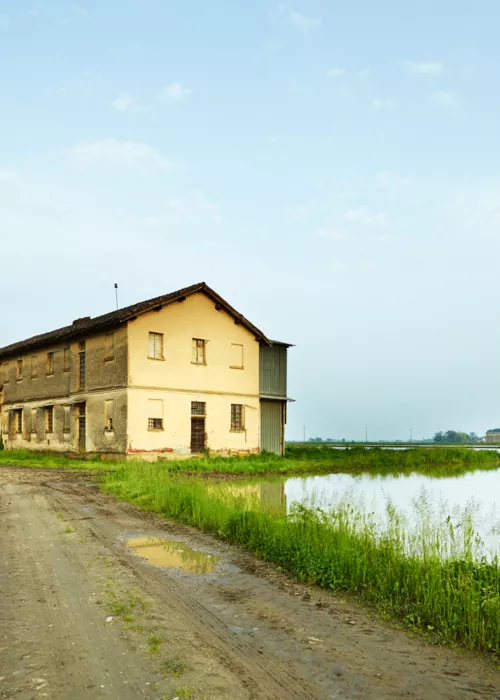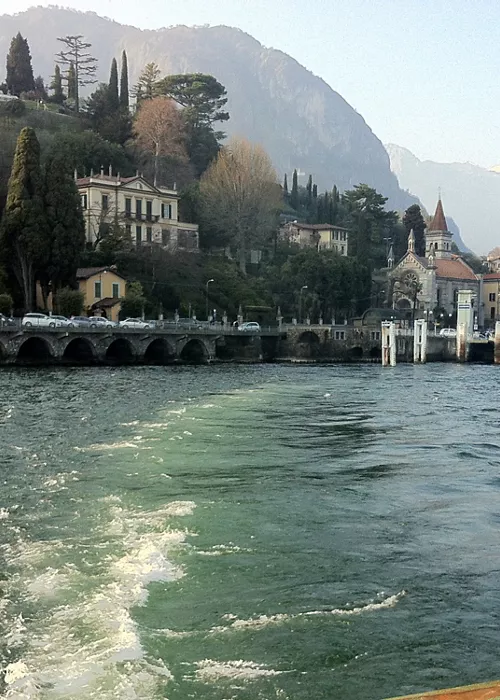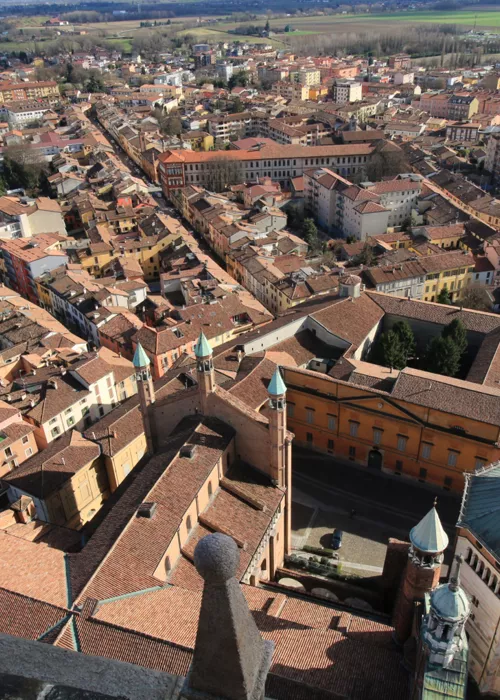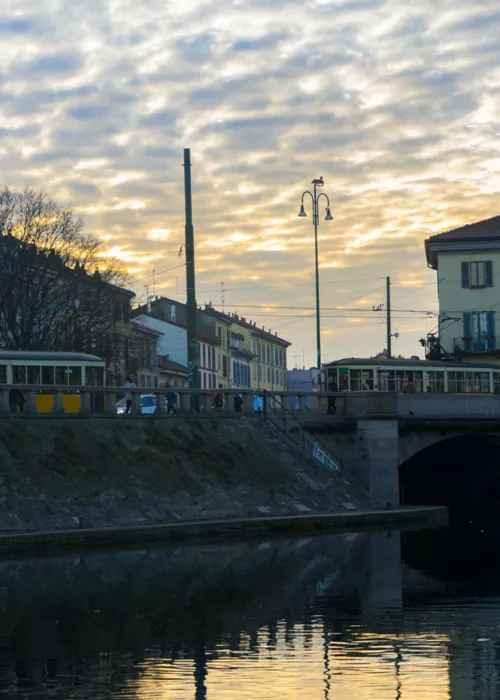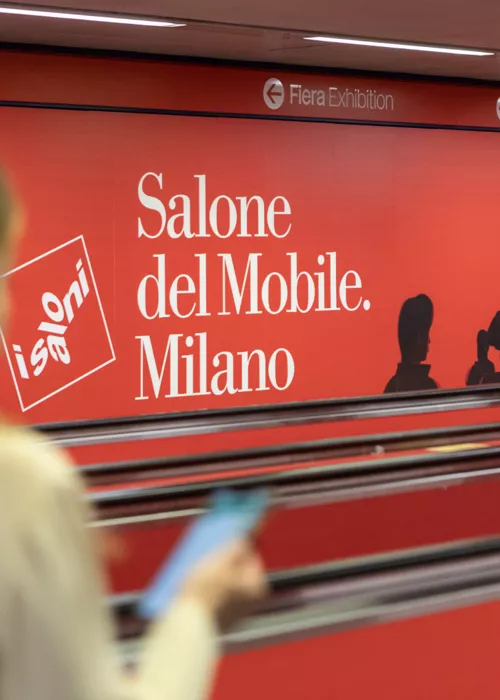The dance of death

The first stop is the fresco of the 'Dance of Death', in front of the bronze portal of the Basilica of Clusone. Three themes are represented: the Triumph of Death, the Dance of Death and the Last Judgement.
It is also called "the fresco of the Novissimi", that is, of the representation of certain knowledge about the ultimate destinies of human life: death, judgement in the afterlife, hell or paradise. At the top, the fresco presents the triumphant death wrapped in a black robe, wearing a crown on his head, standing on a sarcophagi inside which lie the Pope and the Emperor; his arms are wide open and holding two large scrolls: the one on the left admonishes that no man can escape death, while the one on the right reiterates that death is not corrupted by wealth, no one is excluded from it. Next to death are two skeletons: the one on the right shoots using an arquebus, the one on the left shoots arrows with which he pierces clerics and knights. At the foot of the sarcophagi, other characters offer gifts to death, without realising that they are of no use because death cannot be corrupted. In the bottom right, a young horseman is represented who, while hunting, is suddenly thrown off his horse: it is a reinterpretation of the 'Meeting of the three living with the three dead', an iconography used in the Middle Ages to remind one to meditate on one's behaviour in life, because death comes suddenly.
At the bottom, we have the Dance of Death: the characters from the door on the right belong to all social classes and advance in line, each led by the hand of a skeleton, towards the divine judgement.
In the third register of the painting, the Inferno and Paradise are depicted, many parts of which have been lost following the renovation of the building. The few characters we can still admire give us a hint that this is hell, where the seven deadly sins are punished.
The Oratory of the Disciplines

The second stop to discover Clusone through some of the most valuable and significant pictorial works of its cultural heritage is the Oratorio dei Disciplini, located on the west side of the churchyard of the Basilica di S. Maria Assunta, built by the Confraternita dei Disciplini Bianchi, officially approved in 1336.
The old oratory was expanded in the 15th century AD and extended on the left, then - in 1673 - the raising of the entire complex was completed, to create a more spacious room suitable for hosting the meetings of the Disciples, who were constantly increasing in number. The latter intervention caused damage to the fresco outside.
As you enter, you will find yourself immersed in a painted treasure chest: the frescoes cover all the walls of this single hall, the cross vault of the presbytery and the altar area. The walls of the nave are decorated with 42 panels, distributed along three bands, with the narration of the life of Jesus, of which 31 are visible. The succession of scenes follows the iconographic commonality of the Christian tradition: from the wall on the right, it starts from the Annunciation to Jesus' entry into Jerusalem for Easter. In the second register we move on to the episodes from the Last Supper to the Crucifixion, and in the third lower register, although deteriorated, we find the scenes of the Deposition, the Pietà and the Burial. Two compositions follow, with the appearance of Jesus to the disciples and the angel's announcement to the pious women that Christ is risen, the conferring on Peter of the primacy of founder of the Church, and the Ascension of Jesus into heaven.
The date of execution reported in the cycle of frescoes is 1480, but there is no information on the author. Scholars are debating possible attributions; certainly, this is a painter of great creative and technical skills, who pays attention to detail in the characters, always in the foreground. The entire space above the arcosolium (arched architectural type) of the chancel is occupied by the Crucifixion and Death of Jesus on Calvary. Christ on the cross is positioned in the centre, occupying the apex of the arch, while at the sides we find the two thieves. The composition is very complex and picks up on the scheme set by the famous painter Vincenzo Foppa, with the image of the thieves tied with ropes to the arms of the cross, dated 1456, which testifies to the fact that the author was abreast of the latest pictorial solutions. At the foot of the fresco looking to the left is the date 1471 and the signature of the author which today reads incomplete: "CHOB PINXIT". Many names have been put forward, the most accredited hypothesis seems to be the attribution to the painter from Cluson Giacomo de Buschis known as Borlone.
The Fanzago planetary clock

The planetary clock is the third stage in the discovery of Clusone through its frescoes, and can be reached by descending the steps leading from the Oratory of the Disciples to Piazza Orologio.
The author of the astronomical mechanism is a citizen of Cluson, Pietro Fanzago.
The clock is embedded in the tower of the town hall. The outermost frame represents the Wind Rose with 8 winged heads. Next we find the hour ring consisting of a white band bearing the 24 hours of the day marked with Roman numerals. Hours are indicated below the numbers by black circles, half-hours by longer arrows, quarter-hours by smaller arrows. Drawing the sign is a central arrow, in the middle of which is an embossed gilded copper face, representing the Sun.
Three different crowns, divided in turn into bands, give specific astrological and astronomical indications. The first crown has an outer band divided into 12 boxes on which the months of the year are marked. The second band is also divided into squares, on which the signs of the zodiac are depicted. The signs of the zodiac are painted in gold on a blue background and the respective astrological symbols are indicated on the side. The last band is divided into sections with gilded Roman numerals on a black background, representing the duration of day and night. The second crown presents the movable part: the radiant face of the Sun, made of finely embossed and gilded copper, is located in the middle of the pole. The longer master index marks the hours, the months, the length of the night and the position of the Sun in the Zodiac. Particularly peculiar is its anti-clockwise rotation, according to a cycle that is completed within the 24 hours of the day and follows the direction of the Sun's movement from east to west. At the base of the arrow is a disc divided into 29 and a half squares, indicating the days of the lunar phase. On this, the larger arrow marks the days of the Moon's age, while the shorter arrow marks the days of the waning Moon after the full Moon. The third crown represents the vault of heaven: the lines are drawn in gold and group the stars and planets. The Earth is represented by the small eight-pointed star in the centre of the disc; the moon by the circular window at the top. Through the drawn lines, it was possible to calculate the respective future astrologically compatible spouses for the newborns.
The town hall of Clusone

The fourth stage consists of the majestic and austere City Hall, which dominates the square in front and contains the Fanzago Clock. Its construction dates back to 1008.
The palace reflects the purity of medieval architecture, with the building divided into two levels, the lowest of which is marked by six round arches, supported by semi-pillars, the upper one with a few windows and, next to it, the high tower. Finally, the roof with sloping roof with wooden beams.
Outside, the palace is decorated with frescoes with the coats of arms of the families that have succeeded over time to the government of the city: this is to be clear to the entire community, and to those who had come to the city from outside, which was the most powerful family at that time. In the centre of the wall on the square, you can see the remains of a walled Gothic loggia, probably a balcony from which the Podestà overlooked its proclamations. Under the loggia, a well-preserved fresco depicts the Madonna with the Child in her arms, seated on a throne built in Gothic style, between Saints Sigismund, on the right, and Christopher, on the left. The presence of the latter is not accidental: San Cristoforo, with the Child Jesus on his shoulder who pulls a strand of hair, is the protector of travellers, so his presence in the market square was a good omen for a serene return for the merchants who came with their products and for all those who went to visit the city.
The Church of San Defendente and Rocco

Initially it was believed that theChurch, the destination of our fifth stage to the visual discovery of Clusone, had been built between 1470-77; in fact, the analysis of the masonry and frescoes lead to hypothesise that this date refers to the expansion of an oratory already existing and dating back to 900 A.D., dedicated to San Nabore, a holy martyr belonging to the Roman legion and martyred during the Christian persecutions of 303 B.C. After the expansion, the building was dedicated to San Defendente, another martyr soldier belonging to the Tebea legion, composed by Egyptian Christians, who in the fourth century A.D. was transferred to the border with the Alps, at the service of the general Maurizio, who, being a pagan, ordered sacrifices to be made. The legion refused and for this reason was annihilated. The cult of martyrs was widespread in Tours and when, under Charlemagne, the dioceses of the upper Val Seriana passed under the government of the bishop San Martino di Tours, the cult of San Defendente soon spread. In 1477, the building was renovated, following the spread of the plague in the Val Seriana, just as the Venetians acquired the relics of S. Rocco in Voghera, where the saint had died, long after he had contracted the disease, he was miraculously cured. This would explain the spread of his veneration of Clusone, who was then part of the Venetian possessions. In 1575, the portico was built with four columns, the walls of which were painted, on the right, with a Crucifixion with Saints Sigismund, Rocco, Defender, Sebastian and Christopher with Jesus pulling his hair. In 1630, at the outbreak of a new wave of the plague, the Church was transformed into Lazzaretto, while from 1770 the decline began. After years of closure to the public, it was recently renovated. The Church, with a single nave, presents inside frescoes probably all ex voto, commissioned by wealthy families of the place, to thank the saints for the graces received. For this reason, we find the images of San Defendente several times with his golden tunic, his sword and his blonde hair, and images of San Rocco, with his long brown hair, the wound on his right leg and, only in a fresco, portrayed with the little dog who fed him during isolation due to the disease. In the Presbytery, we find a painted altar panel dated 1634, with the canvas representing the transit of St Joseph, supported by Jesus and the Madonna. On the sides, the space is divided by a fake architectural structure formed by round arches.
Towards other stages in the discovery of Clusone

We hope that our "atypical" journey to the discovery of "painted" Clusone, to discover some fascinating secrets by looking at it from unusual "observation points", was to your liking.
However, the suggestions that this characteristic village, with ancient origins, can offer, are many, for history and art lovers, but also for lovers of rural tourism: slow, eco-sustainable, ready to enjoy the tranquillity of these places, cycling on the ValSeriana cycle path or walking through the streets of the historic centre, where they seem to echo the footsteps of excellent characters who have been guests in Clusone over the centuries. To some, perhaps, it will sound like hearing the melodies of the great Giuseppe Verdi, who here, it is said, composed the Attila, while on holiday at the villa of the Countess Maffei. These places, however, are also ideal for lovers of the silence and beauty of nature of this plateau, peaceful and welcoming.


